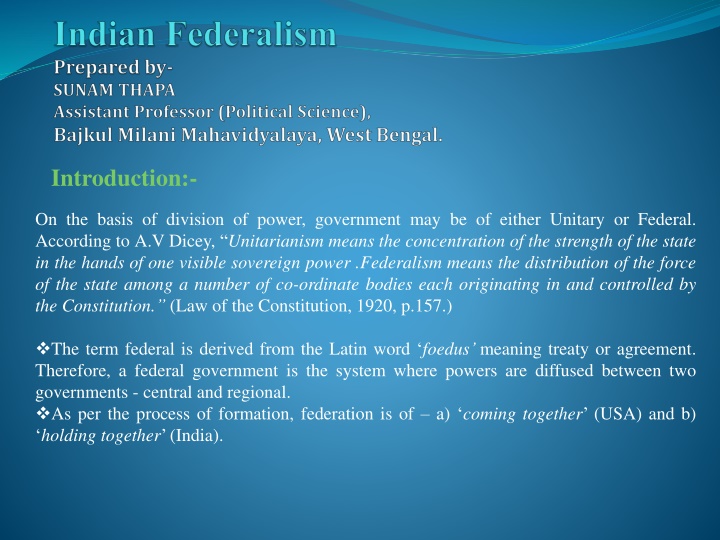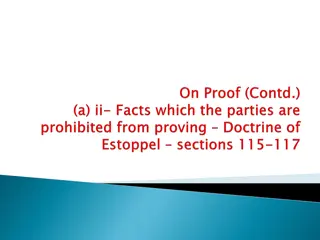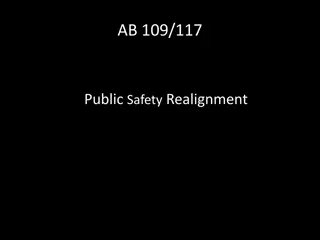
The Unique Indian Federal System
Explore the intricacies of the Indian federal system, a blend of federal and unitary features. Learn about its historical roots, key characteristics, and how it differs from traditional federal models like that of the USA.
Download Presentation

Please find below an Image/Link to download the presentation.
The content on the website is provided AS IS for your information and personal use only. It may not be sold, licensed, or shared on other websites without obtaining consent from the author. If you encounter any issues during the download, it is possible that the publisher has removed the file from their server.
You are allowed to download the files provided on this website for personal or commercial use, subject to the condition that they are used lawfully. All files are the property of their respective owners.
The content on the website is provided AS IS for your information and personal use only. It may not be sold, licensed, or shared on other websites without obtaining consent from the author.
E N D
Presentation Transcript
Introduction:- On the basis of division of power, government may be of either Unitary or Federal. According to A.V Dicey, Unitarianism means the concentration of the strength of the state in the hands of one visible sovereign power .Federalism means the distribution of the force of the state among a number of co-ordinate bodies each originating in and controlled by the Constitution. (Law of the Constitution, 1920, p.157.) The term federal is derived from the Latin word foedus meaning treaty or agreement. Therefore, a federal government is the system where powers are diffused between two governments - central and regional. As per the process of formation, federation is of a) coming together (USA) and b) holding together (India).
other classical federal. Indian model is unique and interesting one. Therefore, Dr. B.R. Ambedkar said, it is unitary in extra-ordinary circumstances such as war and other calamities and federal under normal circumstances. (CAD, 1948). Hence, many commentators has interpreted Indian federalism in many ways, viz. K.C. Wheare termed as quasi federal , Morris Jones as bargaining federalism , Granville Austin as co- operative federalism . In true sense, Indian system is not federal like that of U.S.A and
History plays a major role in shaping any political system. The British rule had impacted much in India. The roots of Indian federal system is found in the following- Government of India Act , 1919- for the first time the state and central subjects were separated each others for legislative, financial and administrative purpose. Simon commission report, 1930- advocated complete autonomy in the provinces including the department of law and order. Nehru Report, 1928- suggested a bicameral legislature with Supreme Court as a highest Court of appeal. Government of India Act, 1935- a precursor of the Indian Constitution (1950). Provides Indian federal state consisting both the British Indian provinces and the princely states. Provides framework of centralised federation with fair amount of provincial autonomy.
As Indian federal model is unique, we found both the Federal and Unitary features at a time. The federal features of Indian Constitution are as follows- Written Constitution Division of power Bicameral legislature Supremacy of the Indian Constitution Impartial and independent Indian judiciary Rigidity of the Indian Constitution
Single Constitution Single Citizenship Emergency Provisions Appointment of Governor Single Unified Judiciary Unequal Representation in the Rajya Sabha
For the convenience , this part is divided into four phase- One-Party Federalism (1952-1967) The inner-party federalism in the Congress Party The demand for creation of states based on language. The resentment against one language for official state communication. Expressive Federalism (1967-1989) The political challenge to the congress party. The rise of strong regional forces. Excessive use of article 356 in opposition-ruled states. Rise of regional demands. Efforts of reconciliation. Source:- The Paradox of CentralisedFederalism : An analysis of the Challenges to India s Federal Design, Ambar Kumar Ghosh, ORF Occasional Paper, September, 2020.
Multi-Party Federalism (1989-2014) Weakening of Congress party at the national level. The creation of coalition governments with regional parties at the centre. The economic reforms and financial autonomy to states. The judicial check centres use of article 356. The strengthening of local-self government. The Return of Dominant Party (2014 onwards) The rise of BJP as the dominant party at the national level. The creation of NITI Aayog and GST Council in the spirit of co-operative federalism. The rise of national federalism. The political assertion of regional parties and regional leaders in the state level elections. States crucial role during pandemic. Source:- The Paradox of CentralisedFederalism : An analysis of the Challenges to India s Federal Design, Ambar Kumar Ghosh, ORF Occasional Paper, September, 2020.
Federalism is a mechanism of power distribution between at least two levels of governments-central and regional. But conceptually Indian context is unique. As a result of the British rule and also to maintain unity in diversity India adopted centralized federalism. Hence, Jawaharlal Nehru cautioned, it would be injurious to the interests of the country to provide for a weak central authority which would be incapable of ensuring peace, of co-ordinating vital matters of common concern and of speaking effectively for the whole country in the international sphere. (CAD, 1948). However, India s experience is dynamic- many factors, viz. regional forces, coalition politics, local-self government, etc help this process.









